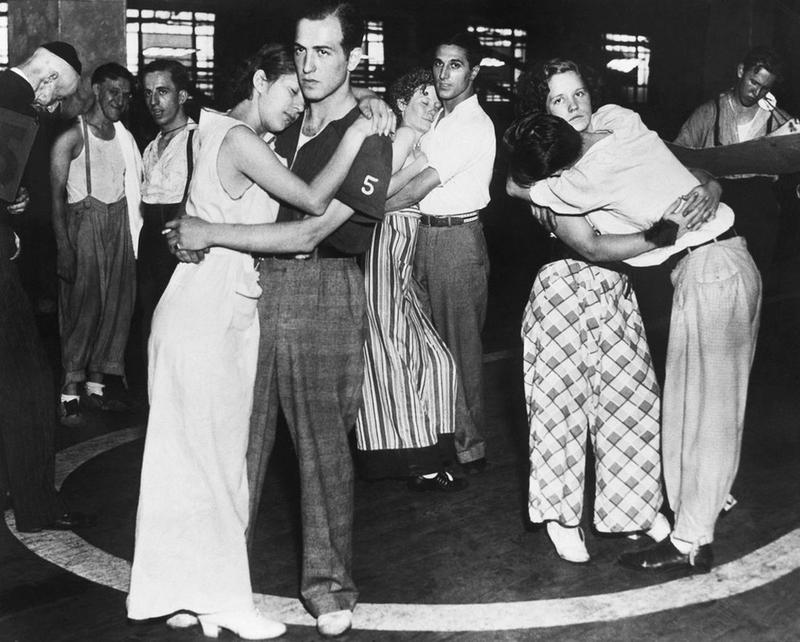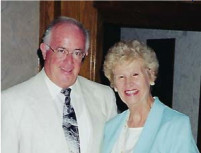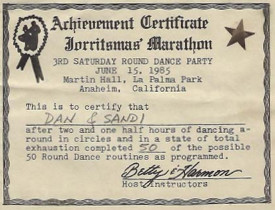|
|
It Only Seems Like A Marathon
by Sandi
& Dan Finch
Dancers new to the “weekend” experience usually complain at the end of
the first day about their brain drain. A lot of new material comes
their way, a lot to absorb especially when the condensed learning
experience is new. The concept of being in a marathon comes to mind.
 In the 1920s and 30s, dance marathons were the rage. Winning meant
prize money during the hard times of the Great Depression, and just
competing meant food for dancers and spectators, a place to sleep (in
short naps) if you were homeless and medical attention if it became
necessary. The rules were simple—keep shuffling. One partner could fall
asleep as long as one could hold the other up and their knees never
touched the floor. Most events allowed a 15-minute break every hour.
They were nicknamed “bunion derbies” and “corn and callus carnivals” or
simply “walkathons,” more descriptive of the movement than actual
dancing.
In the 1920s and 30s, dance marathons were the rage. Winning meant
prize money during the hard times of the Great Depression, and just
competing meant food for dancers and spectators, a place to sleep (in
short naps) if you were homeless and medical attention if it became
necessary. The rules were simple—keep shuffling. One partner could fall
asleep as long as one could hold the other up and their knees never
touched the floor. Most events allowed a 15-minute break every hour.
They were nicknamed “bunion derbies” and “corn and callus carnivals” or
simply “walkathons,” more descriptive of the movement than actual
dancing.
The popularity of dance marathons began in 1923 when a woman named Alma
Cummings danced continuously for 27 hours, with six different partners.
Competitions sprung up to break her record. The public soon found they
were a source of free or cheap entertainment, but it wasn’t long before
church groups opposed to dancing in general began lobbying against
them. Movie theater owners joined the opposition because marathons were
drawing away their patrons. Cities actually began to outlaw them on
hygiene as well as moral grounds. Improving economic times and World
War II contributed to their demise.
Dance marathons didn’t go away completely, though. They have survived
in the form of charity events, mostly on college campuses. Penn State
runs a 46-hour-long dance marathon to raise money to combat children’s
cancer, raising $147 million since 1977. UCLA raised $3 million several
years ago for pediatric research through a dance marathon.
 And marathons have survived just for the fun of it. Harmon and Betty
Jorritsma (pictured), round dance teachers in southern California for
more than 35 years, held an annual marathon every summer. No winners,
but if you stayed on the floor for the full two and half hours and
danced the 50 dances on the program, you got a certificate like the one
pictured at left. (Yes, Dan and I completed at least one of those
marathons, in 1985.) On the program for that marathon were the likes of
Spaghetti Rag, That Happy Feeling, Crazy Eyes, Folsom Prison Blues, and
an occasional waltz such as Answer Me.
And marathons have survived just for the fun of it. Harmon and Betty
Jorritsma (pictured), round dance teachers in southern California for
more than 35 years, held an annual marathon every summer. No winners,
but if you stayed on the floor for the full two and half hours and
danced the 50 dances on the program, you got a certificate like the one
pictured at left. (Yes, Dan and I completed at least one of those
marathons, in 1985.) On the program for that marathon were the likes of
Spaghetti Rag, That Happy Feeling, Crazy Eyes, Folsom Prison Blues, and
an occasional waltz such as Answer Me.
 So, don’t let that marathon feeling deter you from the next weekend
opportunity. Take a break when you need it, absorb all the instructor
has to offer, and know you will eventually see the fun in it. So, don’t let that marathon feeling deter you from the next weekend
opportunity. Take a break when you need it, absorb all the instructor
has to offer, and know you will eventually see the fun in it.
From a club
newsletter, March 2019,
and
reprinted
in the Dixie Round Dance Council (DRDC)
Newsletter, March 2020.

|
